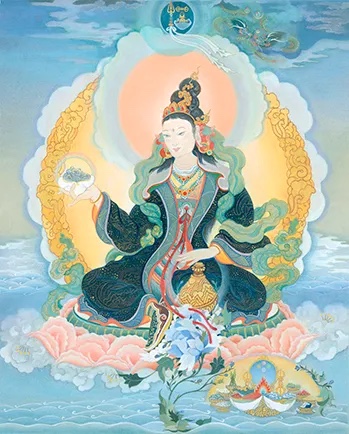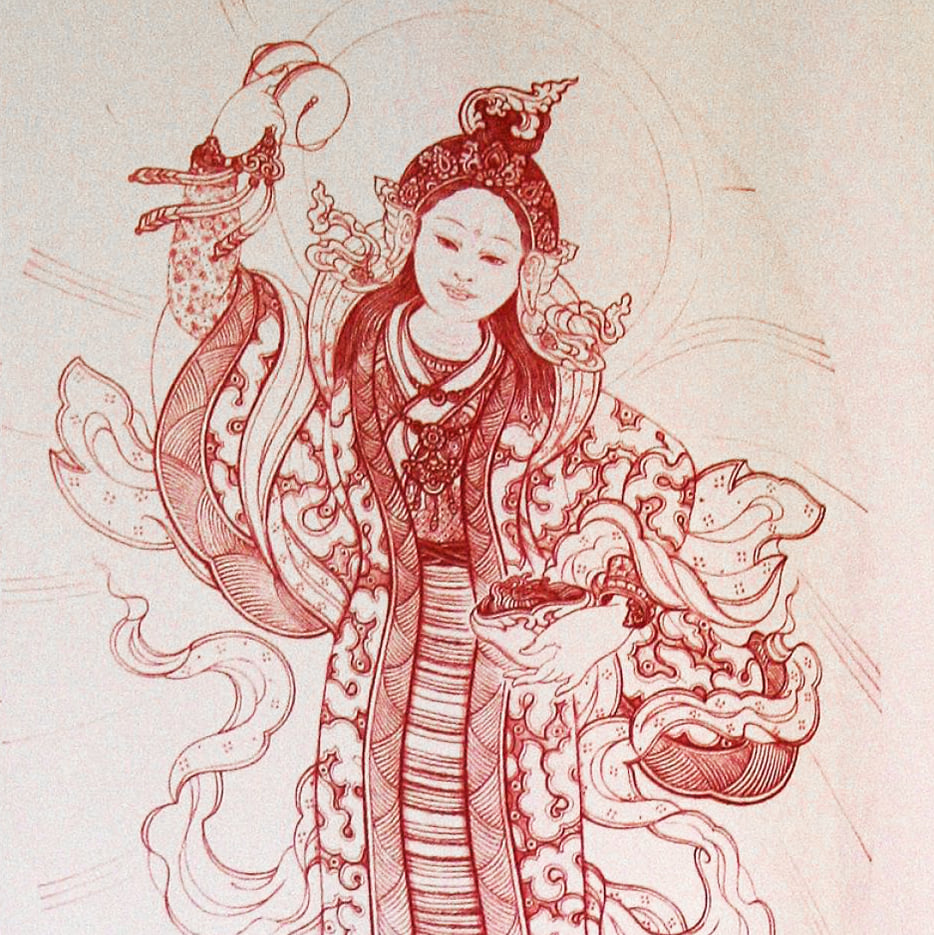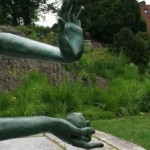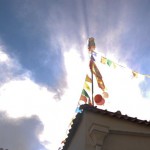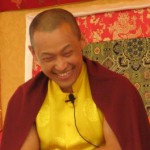Wednesday
Who Was Yeshe Tsogyal?
By Holly Gayley
Holly Gayley discusses the power of Padmasambhava’s foremost disciple and consort, Yeshe Tsogyal, and the life of one of her modern emanations.
Yeshe Tsogyal is the preeminent lady of Tibetan Buddhism. While most—if not all—of what we know about her life is highly mythologized, she is revered by Tibetans as a foremost disciple and consort of Padmasambhava, the eighth-century tantric master credited with a seminal role in establishing Buddhism in Tibet. Yeshe Tsogyal is also celebrated for transcribing Padmasambhava’s teachings and concealing them as treasures across the Tibetan and Himalayan landscape, to be revealed by successive tertöns, or “treasure revealers,” during times of strife.
In her well-known namthar, or story of “complete liberation,” which was revealed by the seventeenth-century tertön Taksham Nuden Dorje (available in English translations by Keith Dowman and the Padmakara Translation Group), Yeshe Tsogyal is portrayed as a gutsy woman striving for enlightenment. She faces various trials while practicing meditation in mountain solitudes: scorn from villagers, torment by demons, starvation, and even rape. Through these trials, she is shown transforming adversity into fuel for her practice and gaining realization. Moreover, in her namthar, one finds the striking statement by Padmasambhava that a woman with strong determination has a greater potential for attaining enlightenment than a man. In this way, Yeshe Tsogyal serves as an important example of a woman who traversed the Buddhist path.
However, if we think of Yeshe Tsogyal primarily as an ancestor who demonstrates that enlightenment is possible in female form, we grossly underestimate her significance for Tibetans. Moreover, we run into the problem (as with so many female figures in Buddhist literature) of establishing her historicity.
For Tibetans, Yeshe Tsogyal is not just a figure from the distant past; she remains an active and enduring presence. In the outer frame of her namthar, we see her portrayed as a timeless being—an emanation of Sarasvati—who took human form in Tibet for the sake of propagating the dharma. And at the end of her tale, before dissolving into space, Yeshe Tsogyal promises to continue to respond to the prayers of devotees, to appear to adepts in visions, and to continue to send forth emanations.
But her story does not end there. Over the centuries, Yeshe Tsogyal has remained accessible to ordinary Tibetans through numerous liturgies that supplicate her. In addition, her potent blessings are understood to remain in the places she practiced as well as the objects she touched (strands of hair, articles of clothing, ritual implements, etc.), considered to be relics of contact. To spiritual virtuosos, both male and female, Yeshe Tsogyal also appears in visions, posing riddles, offering encouragement, or expounding on the contents of a treasure teaching.
What’s more, Yeshe Tsogyal’s presence continues in the lives of historical women who are regarded to be her emanations. Indeed, exceptional women in the Nyingma school of Tibetan Buddhism are often identified as an emanation of Yeshe Tsogyal and sometimes referred to as “Yeshe Tsogyal in person.” Her emanations include the few female tertön known to us, such as Jomo Menmo (thirteenth century) and Sera Khandro (early twentieth century), as well as Mingyur Paldrön, the daughter and successor of the famed seventeenth-century tertön Terdak Lingpa, founder of Mindroling Monastery outside of Lhasa.
From one perspective, we could say that Yeshe Tsogyal serves as an authoritative precedent, creating a cultural space for female religious authority within the otherwise male-dominated Buddhist milieu in Tibet. From another perspective, through the women identified as her emanations, Yeshe Tsogyal continues to be an active presence, intervening in the lives of ordinary Tibetans.
To illustrate this, let me introduce a contemporary female tertön from the region of Golok in eastern Tibet: Khandro Tare Lhamo (1938–2002), an emanation of Yeshe Tsogyal who served as a beacon of hope for her local community during a devastating chapter of Tibetan history. The period leading up to and including the Cultural Revolution (1966–76) witnessed the destruction of most visible symbols of Tibetan culture: monasteries were closed, texts were burned, sacred objects were looted, monks and nuns were forced to defrock, and public religious observances were forbidden. Many lamas fled into exile or died in prison, including Khandro Tare Lhamo’s first husband and three brothers, who were incarcerated in the late 1950s.
Perhaps because she was a woman, Khandro Tare Lhamo was spared imprisonment, though I was told that she did endure beatings. On one harrowing occasion, officials placed her bare chest on a hot wood-burning stove. According to the old woman who told me this story, Khandro Tare Lhamo reflected on the far greater sufferings of beings in the hell realms, and as a result she had no burn marks afterward.
One cannot find such tales in her namthar, Spiraling Vine of Faith. Since it was published in China, most of her personal misfortunes and hardships are left out, likely due to the continued sensitivity of the “Tibet question.” For this reason, the stories told about Khandro Tare Lhamo in her namthar emphasize the miracles she performed for her local community, rather than the trials she endured. For example, during a famine in the wake of the Great Leap Forward, there is no mention of the hunger she and others must have faced; we read only of her miraculous ability to multiply a measure of rice to feed those around her. And while working as part of a crew constructing a pen for wild yaks, she is reported to have carried a stone too heavy for a group of men to lift, leaving an imprint of her hand in it.
These stories show how Khandro Tare Lhamo, as an enlightened being who took rebirth for the sake of others, embodied the paradox of being confined to her historical circumstances while seeming to transcend the laws of nature. Though miraculous in tenor—as when she reportedly stopped a rockslide threatening to overwhelm a crowd with a simple gesture of her hand—her activities were nonetheless grassroots in scale, addressing the immediate needs of her local community.
Khandro Tare Lhamo’s role in the Buddhist revival in Golok beginning in the 1980s was possible due to her identification with Yeshe Tsogyal. With the onset of China’s policy of “reform and opening,” religious observances were once again allowed, and Tibetans began an arduous process of rebuilding monasteries and recovering and reprinting precious texts. In Golok, treasure revelation played a significant role in this revival as a means to recover ancient teachings from amidst the debris. For the Nyingma, treasures are meant to be revealed during troubled times, when they promise to heal the damage to the teachings and beings, thereby heralding a new era for Buddhism and society to flourish.
As an emanation of Yeshe Tsogyal, Khandro Tare Lhamo was understood to have access to the teachings of Padmasambhava in the form of treasures, sealed in the Tibetan landscape and also in the mind stream of the tertön. Together with her second husband, Khandro Tare Lhamo revealed a twelve-volume corpus of treasure literature, including a volume dedicated to Yeshe Tsogyal and a series of female deities. From the mid-1980s onward, the couple traveled and taught together, propagating these treasures.
As these stories show, for Tibetans, Yeshe Tsogyal is more than an ancestor from the distant past or simply a role model to affirm women’s potential for enlightenment. Indeed, she remains an active presence in the lives of Tibetans–both men and women–through rituals dedicated to her and through the historical women who serve as her emanations. The well-known emanations of Yeshe Tsogyal mentioned above are only the tip of the iceberg. As time goes on, more and more stories of female adepts and spiritual teachers in Tibet are coming to light. Indeed, if present circumstances are any indication, for every female Buddhist teacher who made it into the historical record, there were at least a dozen or more on the ground. As the number of studies on exceptional Tibetan women grows, let us hope that we can consider not only issues of gender but also the impact and influence of these women on Buddhist history.
Reposted from Lion’s Roar December 1, 2007
*Judith Simmer-Brown will host Yeshe Tsogyal and the Feminine Principle through Shambhala Online beginning June 17, 2023. To Learn more and register please click here.
Entries filed under Dharma Teachings
Inspirational Teachings from the Dignity Weekend with the Sakyong – HIGHLIGHT
by Director of Shambhala Europe, Chris Montone From October 7th – 9th, 435 Shambhala leaders from 125 centers and groups who had attended one of the 10 Kalapa Governance Gatherings offered this year, gathered in Halifax, Nova Scotia to hear the Sakyong teach about governance and the ... continuePosted November 28, 2011 by
Karme Choling’s Garden Gate – HIGHLIGHT
Slogan of the week: Stop, Drop and Touch the Speechless Sky by Jan Enthoven, Master Gardener at Karme Choling Meditation Retreat Center Many people ponder how humanity can continue its proliferation on planet earth with its limited material resources and a rapidly widening ecological footprint. I am just ... continuePosted November 20, 2011 by
Stop. Give – HIGHLIGHT
This article presents healthy ways to keep your heart open when friends are too needy. This guest article is contributed by Susan Piver, New York Times bestselling author and Shambhala practitioner. In addition to helping you relax and discover your own wisdom, meditation is a way of ... continuePosted November 5, 2011 by
Four more languages have Shambhala YouTube Channels
Following up on the tremendous multilingual efforts for the Shambhala Lineage Festival, there is more good news on the multilingual Shambhala front. In the last two weeeks four more languages have Shambhala YouTube Channels launched. They are mostly still in a “beta” phase as we refine the ... continuePosted October 13, 2011 by Hamish_MacLaren
The Summer of Basic Goodness, part two – HIGHLIGHT
Shastri Column: Article by Shastri Betsy Pond. In part one of this article, Shastri Pond, from Schertz, Texas expounded upon the teachings of basic goodness. In part two, she invites us to join her in taking the plunge to feel basic goodness…read on to find ... continuePosted October 10, 2011 by
The Summer of Basic Goodness, part one – HIGHLIGHT
Shastri Column: This is the second in a series of articles by Shastris – senior Shambhala teachers – on themes that Sakyong Mipham Rinpoche has been emphasizing in his teaching since he ended his year-long retreat in early March, 2011.This article is by Shastri Betsy Pond ... continuePosted October 6, 2011 by
Bravery: Synchronicity of Body and Mind – HIGHLIGHT
by Sakyong Mipham “We have quickly realized that without synchronicity, we are only idling in the dark age.” When we realize the power of aligning our mind and body with our surroundings, we are able to be dignified and courageous because synchronizing our thoughts, actions, and the environment ... continuePosted September 16, 2011 by
Discovering Basic Goodness Through Conversation – HIGHLIGHT
New: Shastri Column! This is the first in a series of articles by Shastris – senior Shambhala teachers – on themes that Sakyong Mipham Rinpoche has been emphasizing in his teaching since he ended his year-long retreat in early March, 2011.This article is by Shastri Susan ... continuePosted September 14, 2011 by
Moving with the Mind of Meditation – HIGHLIGHT
Have you heard? The Sakyong, Mipham Rinpoche, has written a book on running and meditation. The forthcoming book is entitled: “Running with the Mind of Meditation.” The publisher, Crown Doubleday, has expressed real excitement about the book, and given a definite commitment to get it on ... continuePosted August 19, 2011 by
Mythology and Everyday Life
I’ve been wondering lately what Joseph Campbell would think of Shambhala Buddhism. He attributed many of the problems we face today, particularly our disconnect from nature and the resultant chaos & confusion found in our global society, to a lack of a working mythology. ... continuePosted July 28, 2011 by Travis_May
On Basic Goodness – HIGHLIGHT
This video clip of a recent teaching by Sakyong Mipham Rinpoche hails from the recent sangha retreat at Dechen Choling, entitled Being Brave: Transforming Our World. This message of basic goodness is something the Sakyong would like us all to hear, so please, take a few ... continuePosted July 22, 2011 by
Bravery: Taking a Leap – HIGHLIGHT
by Sakyong Mipham Bravery is a highlight of the Shambhala teachings. On the sacred path of the warrior, it is one of the unconditioned qualities that arises from living with virtue and valor. It is defined as “the act of both personally and socially manifesting.” To put it ... continuePosted July 19, 2011 by
Bravery: The Vision of the Great Eastern Sun – HIGHLIGHT
by Sakyong Mipham Bravery is a highlight of the Shambhala teachings, which were introduced to the West by my father, Chögyam Trungpa Rinpoche. In an an earlier teaching I describe the first form of bravery, freedom from deception. I’ve also introduced the second bravery, abruptness — the ... continuePosted July 13, 2011 by
From the Archives: The Fourth Moment – HIGHLIGHT
In anticipation of the 24th Parinirvana of the Vidyadhara, Chogyam Trungpa Rinpoche on April 4th, the Shambhala Times shares an excerpt from a lecture by Trungpa Rinpoche during the first summer session of the Naropa Institute in July 1974. Originally titled, “Meditation and the Fourth Moment,” ... continuePosted April 3, 2011 by
![]() RSS feed for the Dharma Teachings category
RSS feed for the Dharma Teachings category
View all posts from authors in Dharma Teachings: Jillian_Johnson

